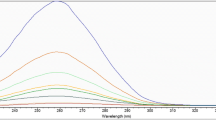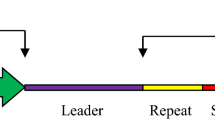Abstract
The centromere is a multi-functional complex comprising centromeric DNA and a number of proteins. To isolate unidentified centromeric DNA sequences, centromere-specific histone H3 variants (CENH3) and chromatin immunoprecipitation (ChIP) have been utilized in some plant species. However, anti-CENH3 antibody for ChIP must be raised in each species because of its species specificity. Production of the antibodies is time-consuming and costly, and it is not easy to produce ChIP-grade antibodies. In this study, we applied a HaloTag7-based chromatin affinity purification system to isolate centromeric DNA sequences in tobacco. This system required no specific antibody, and made it possible to apply a highly stringent wash to remove contaminated DNA. As a result, we succeeded in isolating five tandem repetitive DNA sequences in addition to the centromeric retrotransposons that were previously identified by ChIP. Three of the tandem repeats were centromere-specific sequences located on different chromosomes. These results confirm the validity of the HaloTag7-based chromatin affinity purification system as an alternative method to ChIP for isolating unknown centromeric DNA sequences. The discovery of more than two chromosome-specific centromeric DNA sequences indicates the mosaic structure of tobacco centromeres.





Similar content being viewed by others
Abbreviations
- 2, 4-D:
-
2, 4-Dichlorophenoxyacetic acid
- ANOVA:
-
Analysis of variance
- CENH3:
-
Centromere-specific histone H3 variant
- ChIP:
-
Chromatin immunoprecipitation
- ChIP-qPCR:
-
Real-time quantitative PCR with ChIP DNA
- DAPI:
-
4,6-Diamino-2-phenylindole
- FISH:
-
Fluorescence in situ hybridization
- HFD:
-
Histone fold domain
- PBS:
-
Phosphate-buffered saline
- PMSF:
-
Phenylmethylsulfonyl fluoride
- qPCR:
-
Real-time quantitative PCR
- Tukey HSD:
-
Tukey’s Honestly Significant Difference
References
Ananiev EV, Phillips RL, Rines HW (2000) Complex structure of knobs and centromeric regions in maize chromosomes. Tsitol Genet 34:11–15
Chang SB, Yang TJ, Datema E, van Vugt J, Vosman B, Kuipers A, Meznikova M, Szinay D, Lankhorst RK, Jacobsen E, de Jong H (2008) FISH mapping and molecular organization of the major repetitive sequences of tomato. Chromosome Res 16:919–933
Cheng Z, Dong F, Langdon T, Ouyang S, Buell CR, Gu M, Blattner FR, Jiang J (2002) Functional rice centromeres are marked by a satellite repeat and a centromere-specific retrotransposon. Plant Cell 14:1691–1704
Choo KHA (1997) The centromere. Oxford University Press, Oxford
Dong F, Miller JT, Jackson SA, Wang GL, Ronald PC, Jiang J (1998) Rice (Oryza sativa) centromeric regions consist of complex DNA. Proc Natl Acad Sci USA 95:8135–8140
Earnshaw WC, Rothfield N (1985) Identification of a family of human centromere proteins using autoimmune sera from patients with scleroderma. Chromosoma 91:313–321
Foltz DR, Jansen LET, Bailey AO, Yates III JR, Bassett EA, Wood S, Black BE, Cleveland DW (2009) Centromere-specific assembly of CENP-A nucleosomes is mediated by HJURP. Cell 137:472–484
Fukagawa T (2004) Centromere DNA, proteins and kinetochore assembly in vertebrate cells. Chromosome Res 12:557–567
Furuyama T, Dalal Y, Henikoff S (2006) Chaperone-mediated assembly of centromeric chromatin in vitro. Proc Natl Acad Sci USA 103:6172–6177
Gazdova B, Siroky J, Fajkus J, Brzobohaty B, Kenton A, Parokonny A, Heslop-Harrison JS, Palme K, Bezdek M (1995) Characterization of a new family of tobacco highly repetitive DNA, GRS, specific for the Nicotiana tomentosiformis genomic component. Chromosome Res 3:245–254
Gill N, Findley S, Walling JG, Hans C, Ma J, Doyle J, Stacey G, Jackson SA (2009) Molecular and chromosomal evidence for allopolyploidy in soybean. Plant Physiol 151:1167–1174
Han F, Lamb JC, Birchler JA (2006) High frequency of centromere inactivation resulting in stable dicentric chromosomes of maize. Proc Natl Acad Sci USA 103:3238–3243
Henikoff S, Ahmad K, Malik HS (2001) The centromere paradox: stable inheritance with rapidly evolving DNA. Science 293:1098–1102
Heun P, Erhardt S, Blower MD, Weiss S, Skora AD, Karpen GH (2006) Mislocalization of the Drosophila centromerespecific histone CID promotes formation of functional ectopic kinetochores. Dev Cell 10:303–315
Hosouchi T, Kumekawa N, Tsuruoka H, Kotani H (2002) Physical map-based sizes of the centromeric regions of Arabidopsis thaliana chromosomes 1, 2, and 3. DNA Res 9:117–121
Houben A, Schroeder-Reiter E, Nagaki K, Nasuda S, Wanner G, Murata M, Endo TR (2007) CENH3 interacts with the centromeric retrotransposon cereba and GC-rich satellites and locates to centromeric substructures in barley. Chromosoma 116:275–283
Hudakova S, Michalek W, Presting GG, ten Hoopen R, dos Santos K, Jasencakova Z, Schubert I (2001) Sequence organization of barley centromeres. Nucleic Acids Res 29:5029–5035
Jakowitsch J, Papp I, Matzke MA, Matzke AJM (1998) Identification of a new family of highly repetitive DNA, NTS9, that is located predominantly on the S9 chromosome of tobacco. Chromosome Res 6:649–659
Jiang J, Birchler JA, Parrott WA, Dawe RK (2003) A molecular view of plant centromeres. Trends Plant Sci 8:570–575
Kato K, Matsumoto T, Koiwai A, Mizusaki S, Nishida K, Noguchi M, Tamaki E (1972) Liquid suspension culture of tobacco cells. Proceedings of IV IFS: fermentation technology, pp 680–695
Malik HS, Henikoff S (2002) Conflict begets complexity: the evolution of centromeres. Curr Opin Genet Dev 12:711–718
Malik HS, Vermaak D, Henikoff S (2002) Recurrent evolution of DNA-binding motifs in the Drosophila centromeric histone. Proc Natl Acad Sci USA 99:1449–1454
Mathur J, Szabados L, Schaefer S, Grunenberg B, Lossow A, Jonas-Straube E, Schell J, Konez C, Konez-Kalman Z (1998) Gene identification with sequenced T-DNA tags generated by transformation of Arabidopsis cell suspension. Plant J 13:707–716
Murata M (2002) Telomeres and centromeres in plants. Curr Genet 3:527–538
Murata M, Ogura Y, Motoyoshi F (1994) Centromeric repetitive sequences in Arabidopsis thaliana. Jpn J Genet 69:361–370
Nagaki K, Murata M (2005) Characterization of CENH3 and centromere-associated DNA sequences in sugarcane. Chromosome Res 13:195–203
Nagaki K, Talbert PB, Zhong CX, Dawe RK, Henikoff S, Jiang J (2003) Chromatin immunoprecipitation reveals that the 180-bp satellite repeat is the key functional DNA element of Arabidopsis thaliana centromeres. Genetics 163:1221–1225
Nagaki K, Cheng Z, Ouyang S, Talbert PB, Kim M, Jones KM, Henikoff S, Buell CR, Jiang J (2004) Sequencing of a rice centromere uncovers active genes. Nat Genet 36:138–145
Nagaki K, Kashihara K, Murata M (2009a) A centromeric DNA sequence colocalized with a centromere-specific histone H3 in tobacco. Chromosoma 118:249–257
Nagaki K, Walling J, Hirsch C, Jiang J, Murata M (2009b) Structure and evolution of plant centromeres. In: Ugarkovic D (ed) Centromere, progress in molecular and subcellular biology. Springer, Berlin, pp 153–179
Nagaki K, Shibata F, Suzuki G, Kanatani A, Ozaki S, Hironaka A, Kashihara K, Murata M (2011) Coexistence of NtCENH3 and two retrotransposons in tobacco centromeres. Chromosome Res 19:591–605
Nakagawa T, Kurose T, Hino T, Tanaka K, Kawamukai M, Niwa Y, Toyooka K, Matsuoka K, Jinbo T, Kimura T (2007) Development of series of gateway binary vectors, pGWBs, for realizing efficient construction of fusion genes for plant transformation. J Biosci Bioeng 104:34–41
Nasuda S, Hudakova S, Schubert I, Houben A, Endo T (2005) Stable barley chromosomes without centromeric repeats. Proc Natl Acad Sci USA 102:9842–9847
Obuse C, Yang H, Nozaki N, Goto S, Okazaki T, Yoda K (2004) Proteomics analysis of the centromere complex from HeLa interphase cells: UV-damaged DNA binding protein 1 (DDB-1) is a component of the CEN-complex, while BMI-1 is transiently co-localized with the centromeric region in interphase. Genes Cells 9:105–120
Ohana RF, Encell LP, Zhao K, Simpson D, Slater MR, Urh M, Wood KV (2009) HaloTag7: a genetically engineered tag that enhances bacterial expression of soluble proteins and improves protein purification. Protein Expr Purif 68:110–120
Ohzeki J-i, Nakano M, Okada T, Masumoto H (2002) CENP-B box is required for de novo centromere chromatin assembly on human alphoid DNA. J Cell Biol 159:765–775
Okada M, Cheeseman I, Hori T, Okawa K, McLeod I, Yates JR, Desai A, Fukagawa T (2006) The CENP-H-I complex is required for the efficient incorporation of newly synthesized CENP-A into centromeres. Nat Cell Biol 8:446–457
Shibata F, Murata M (2004) Differential localization of the centromere-specific proteins in the major centromeric satellite of Arabidopsis thaliana. J Cell Sci 117:2963–2970
Tek AL, Kashihara K, Murata M, Nagaki K (2010) Functional centromeres in soybean include two distinct tandem repeats and a retrotransposon. Chromosome Res 18:337–347
Warburton PE, Cooke CA, Bourassa S, Vafa O, Sullivan BA, Stetten G, Gimelli G, Warburton D, Tyler-Smith C, Sullivan KF, Poirier GG, Earnshaw WC (1997) Immunolocalization of CENP-A suggests a distinct nucleosome structure at the inner kinetochore plate of active centromeres. Curr Biol 7:901–904
Wevrick R, Willard HF (1989) Long-range organization of tandem arrays of alpha satellite DNA at the centromeres of human chromosomes: high-frequency array-length polymorphism and meiotic stability. Proc Natl Acad Sci USA 86:9394–9398
Zhong CX, Marshall JB, Topp C, Mroczek R, Kato A, Nagaki K, Birchler JA, Jiang J, Dawe RK (2002) Centromeric retroelements and satellites interact with maize kinetochore protein CENH3. Plant Cell 14:2825–2836
Acknowledgments
This work was supported by the Program for the Promotion of Basic and Applied Researches for Innovations in Bio-oriented Industry (BRAIN). Seeds of N. tabacum were kindly provided by the Japan Tobacco Inc. pGWB2 vector was a kind gift from Dr. Nakagawa of Shimane University, Japan.
Author information
Authors and Affiliations
Corresponding author
Additional information
Communicated by K. Toriyama.
K. Nagaki and F. Shibat contributed equally to this work.
Electronic supplementary material
Below is the link to the electronic supplementary material.
Rights and permissions
About this article
Cite this article
Nagaki, K., Shibata, F., Kanatani, A. et al. Isolation of centromeric-tandem repetitive DNA sequences by chromatin affinity purification using a HaloTag7-fused centromere-specific histone H3 in tobacco. Plant Cell Rep 31, 771–779 (2012). https://doi.org/10.1007/s00299-011-1198-4
Received:
Revised:
Accepted:
Published:
Issue Date:
DOI: https://doi.org/10.1007/s00299-011-1198-4




